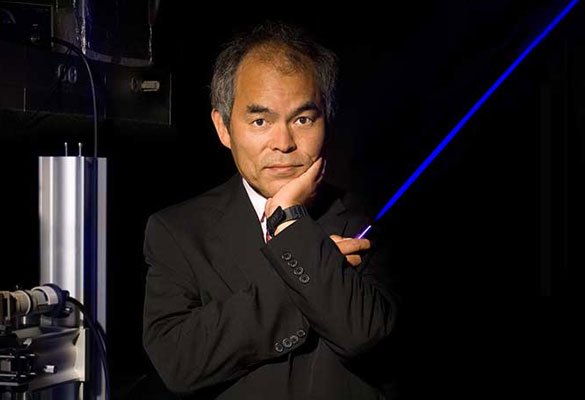When you glance at the crisp white light illuminating your smartphone or marvel at a vibrant screen, you’re witnessing the legacy of a singular discovery — the invention of the blue LED. Central to this breakthrough is Shuji Nakamura, a trailblazing inventor who reshaped the world of technology. Nakamura’s blue LED won him global recognition and transformed the electronics, communications, and energy industries. This blog takes you through Nakamura’s extraordinary life, the challenges he faced, and the groundbreaking legacy he left behind.
Early Life and Education
Born on May 22, 1954, in Ikata, Japan, Shuji Nakamura grew up in a rural fishing village on the island of Shikoku. Far from the bustling centers of industry, young Shuji’s curiosity about the workings of technology took root in the simplicity of his surroundings. Inspired by the advancement of Japanese industries following World War II, he pursued an education in electronics.
He earned his degree in electrical engineering from the University of Tokushima in 1977. However, his early years didn’t point directly to his monumental achievements. He wasn’t immediately regarded as a star student or an exceptional talent in the field. Nakamura’s story is about persistence and the uphill battle to prove one’s worth.
Career Beginnings at Nichia Corporation
Shuji Nakamura began his career at Nichia Corporation, a small chemical company in Tokushima, Japan. Nichia specializes in phosphors, which are materials used in fluorescent lighting. Unlike the elite academic laboratories or industrial powerhouses, Nichia was an unlikely venue for groundbreaking innovation.
Initially, Nakamura worked on traditional projects, but things began to shift when the company tasked him with developing a blue light-emitting diode (LED). At the time, creating a blue LED seemed almost mythical—previous attempts by researchers used established technologies, but none succeeded in producing stable and efficient blue light.
Despite scant resources and immense skepticism (both within and outside Nichia), Nakamura took on the challenge. His narrative epitomizes the professional struggles of limited funding and recognition. Added to this was Nakamura’s status as an engineer working in relative obscurity within intellectual property (IP)-focused corporate environments, where patents and trademarks often overshadowed individual contributions.

The Breakthrough Moment – The Blue LED
For decades, red and green LEDs were common, but the lack of a blue LED severely limited progress in LED technology. Without blue light, creating white light via LEDs was impossible. Shuji Nakamura’s breakthrough was finding the right semiconductor material — a daunting and highly technical challenge.
After years of intense trial and error, Nakamura pioneered using gallium nitride (GaN) as the primary material. GaN became the key to achieving high-efficiency blue light. Nakamura developed innovative methods for growing GaN crystals on sapphire substrates, finally enabling the stable production of blue LEDs.
Blue LEDs revolutionized the lighting industry, allowing for the creation of energy-efficient white light. They paved the way for energy savings worldwide, as LED technology consumes significantly less electricity than traditional incandescent bulbs.
Nakamura’s achievement also underscored the importance of intellectual property rights (IPR). His invention was patented, and his employer, Nichia Corporation, quickly secured the technology’s trademark. Today, blue LED innovations represent some of the most valuable IP assets in the lighting and display industries.
Intellectual Property Challenges and Recognition
Despite his technology’s success, Nakamura’s battle was far from over. Nichia held all the patents for his invention, and Nakamura himself received limited recognition initially. Frustrated by the disparity between his invention’s impact and compensation, Nakamura left Nichia in 2000 and filed a landmark lawsuit.
The legal battle over the intellectual property rights ignited discussions about the rights of inventors versus the corporations they work for. Nakamura’s case was a turning point, drawing attention to the need for fair recognition and rewards for innovators contributing to patented and trademarked breakthroughs.
The lawsuit concluded in a historic settlement, with Nichia compensating Nakamura with ¥840 million (~$8.1 million at the time). This moment redefined corporate practices in Japan regarding how inventors are rewarded for their work.
Nakamura’s contributions didn’t go unnoticed by the global scientific community. In 2014, he and two other Japanese scientists, Isamu Akasaki and Hiroshi Amano, were awarded the Nobel Prize in Physics for inventing efficient blue LEDs. The Nobel Committee emphasized how the blue LED has brought sustainable technologies to the forefront, benefiting the world.
Impact and Legacy
The invention of the blue LED has had far-reaching implications across numerous industries. Thanks to Nakamura’s discovery, LEDs now light up homes, offices, and streets worldwide, reducing energy consumption and environmental impact. Beyond lighting, blue LEDs have become indispensable in electronic displays, medical devices, and communications.
The blue LED’s energy efficiency contributes to global sustainability efforts. Estimates suggest that widespread adoption of LED lighting could reduce global electricity demands by up to 40%. Its influence extends into underdeveloped regions, providing affordable and efficient lighting in communities with limited electricity access.
Nakamura’s story also demonstrates the importance of fostering innovation. His disputes over intellectual property highlighted the need for fair patent systems and corporate policies that balance innovation incentives with corporate profits.
Today, Nakamura continues advancing LED technology and other revolutionary fields such as laser diodes. He co-founded Soraa, a leading company in cutting-edge LED and lighting solutions, further cementing his position as one of the most important inventors of our time.

Illuminating the Future through Innovation
Shuji Nakamura’s invention of the blue LED didn’t just spark a technological revolution—it illuminated the path for future innovations in energy efficiency, sustainability, and display technology. His dedication, resilience, and fight for fair recognition inspire inventors, students, and thinkers worldwide.
Nakamura’s contributions remind us of the critical crossroads between science, business, and intellectual property law. For aspiring scientists and innovators, his story exemplifies how persistence in the face of challenges shapes history.
Want to read more about breakthrough technologies and the visionaries behind them? Stay tuned for our upcoming features celebrating innovation.


